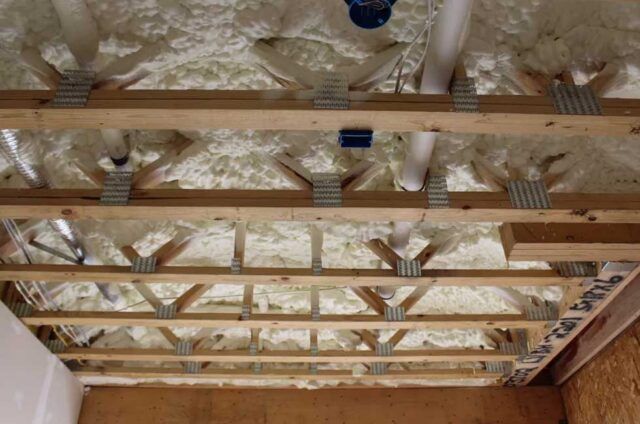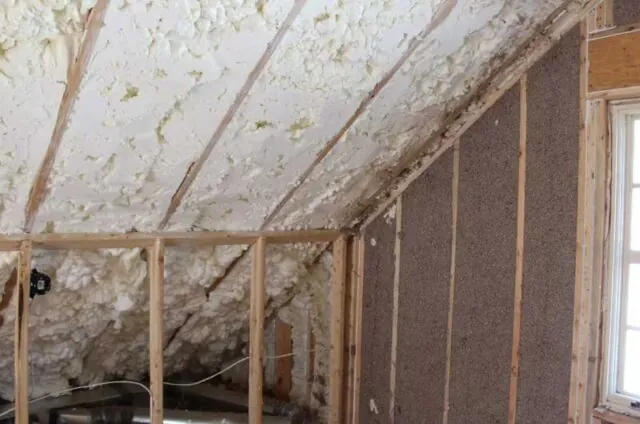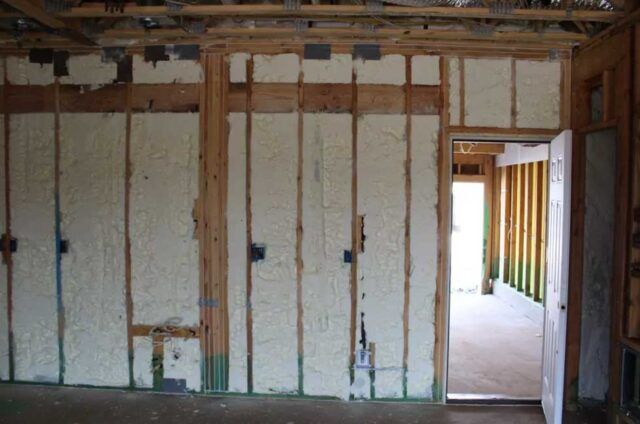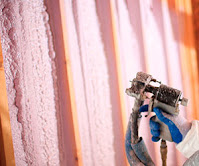Climate Zone Context

Here in Virginia, our hot, humid summers and cold winters land us directly in climate zone 4A, a mixed-humid zone. In this region, maintaining a comfortable home with effective insulation is crucial. Insulation performance is measured by R-value, which is a measure of a material’s thermal resistance. The higher the R-value, the better the insulation works at stopping heat from escaping or entering your home.
Having the right insulation R-value in our climate zone can make a big difference in energy bills and your comfort. That’s why Virginia has an approved statewide residential energy code to make sure newly built homes are consistently energy efficient. The state follows the 2021 Virginia Residential Code, based on the 2021 International Energy Conservation Code (IECC) guidelines. Each climate zone and their energy needs are considered when creating these standards.
Open Cell vs. Closed Cell Spray Foam Comparison
Many Virginia homeowners choose to use spray foam insulation for their homes. Spray foam is the gold standard when it comes to insulation and unlike other types, it slows heat transfer and seals air leaks in one product. There are two main types of spray foam: open cell and closed cell. Here’s how they compare.
Key Structural Differences
- Closed cell spray foam insulation has dense, compact cells filled with gas, making it rigid and strong.
- Open cell spray foam insulation is less dense and has open cells that give it a softer, spongier texture.
R-Value Performance Comparison
The R-value of spray foam insulation is different than that of other types of insulation. Spray foam’s R-value depends on the type of spray foam you use, with slight variations based on the chosen product.
- Closed cell spray foam insulation has an R-value of approximately R-6 to R-7 per inch.
- Open cell spray foam insulation has an R-value of approximately R-3.5 to R-4 per inch.
In tight spaces, closed-cell foam is often the better choice because it packs more insulation into less space.
Moisture Permeability
Moisture control also varies:
- Closed cell spray foam resists moisture and can act as a vapor retarder at the right inch thickness.
- Open cell spray foam lets moisture through and often needs a separate vapor barrier.
Additional Properties
- Both types create an air seal by expanding into gaps.
- Closed cell foam adds extra structural strength to your walls and roof, while open cell foam remains flexible.
- Open cell slightly outshines closed cell in sound absorption.
- Open cell generally costs less per volume than closed cell.
Attic Spray Foam Thickness Requirements

As we discuss the right amounts of insulation you’ll need for your home, it’s important to note that the information given follows industry standards, but application for individual suppliers and different products can vary slightly. It’s always best to speak with an insulation professional for the most tailored and up-to-date insulation solutions for your home.
Target R-Value Goals
For climate zone 4A (where most of Virginia falls), ENERGY STAR guidelines and our state code call for a minimum of R-60 of insulation in unvented attics (AKA the ceiling of the floor below) of new or majorly renovated homes with no insulation. This is the best place to start to provide optimal energy efficiency.
Closed Cell Foam Thickness for Attics
To hit R-60, you’ll need about 8.5 to 10 inches of closed cell foam. Previous standards called for a lower R-value to meet energy codes, so this sets a higher bar of energy efficiency.
Open Cell Foam Thickness for Attics
With open cell spray foam insulation expect to need about 17 inches of foam to reach R-60.
In some cases, where space is tight, installers use a hybrid approach of thin closed cell foam plus blown-in insulation.
Application Methods
Spray foam can be sprayed on your attic floor if proper ventilation is ensured. It is better when it is applied to the underside of your roof deck to create a conditioned, unvented attic space. No matter the method, it’s critical that spray foam insulation thickness is even across the surface to maximize its effectiveness.
Wall Spray Foam Thickness Requirements
Virginia Wall Insulation Standards
Exterior above-grade walls typically need about R-13 to R-20 in insulation. The traditional approach is to install R-13 of fiberglass batts in 2×4 stud walls. Newer energy codes push for about R-20 in walls, which is achievable with either larger 2×6 stud walls or added continuous insulation.
Closed Cell Foam in Wall Applications
- In a 2×4 wall cavity (about 3.5 inches deep), closed cell foam provides around R-20+.
- In a 2×6 wall cavity (about 5.5 inches deep), it can go beyond R-30, exceeding code requirements.
- It has a high R-value per inch which is beneficial where space is limited. It also creates an air seal and strengthens the wall.
Open Cell Foam in Wall Applications
- In a 2×4 wall, open cell foam reaches about R-12 to R-13, falling a bit below modern recommendations.
- You’ll need a 2×6 wall to hit around R-19 with open cell foam.
- In many cases, contractors combine open cell spray foam with exterior foam boards for added R-value.
Installation Considerations
Proper installation is extremely important. Gaps or compressions can reduce your insulation’s performance. Luckily, spray foam expands to fill cracks, offering effective air sealing and a continuous thermal barrier. However, in our humid, damp climate, open cell spray foam insulation requires a separate vapor barrier on the interior side.
Basement and Crawl Space Spray Foam Thickness
Code Requirements for Below-Grade Areas
Basement and crawl space walls, and rim joists in climate zone 4A need about R-13 of insulation.
Closed-Cell Foam in Basements/Crawl Spaces
Closed cell spray foam insulation is the recommended spray foam for these areas thanks to its moisture barrier. It only takes about two inches of closed cell foam applied to the interior side of your foundation walls, at the rim joists, to meet the R-value requirement. It does an outstanding job of satisfying insulation requirements while sealing air leaks and inhibiting moisture.
Open-Cell Foam Considerations for Below-Grade
Open cell spray foam insulation should not be installed on below-grade walls due to its lack of a vapor barrier. It and can easily absorb moisture and lead to mold or mildew issues.
Benefits of Proper Below-Grade Insulation
- Warmer first floors in winter.
- Lower energy bills from reduced heat loss.
- Less risk of mold or moisture problems.
- A cleaner, drier crawl space when paired with good sealing.
Tailored Insulation Solutions for Your Virginia Home
 To sum it up, the answer to “How thick does spray foam need to be?” isn’t one-size-fits-all. It varies based on your climate zone, insulation location, and the types of spray foam insulation you use.
To sum it up, the answer to “How thick does spray foam need to be?” isn’t one-size-fits-all. It varies based on your climate zone, insulation location, and the types of spray foam insulation you use.
It’s important to work with experienced pros like Southland Insulators to make sure your insulation is safe, effective, and code compliant. At Southland, our team of energy experts takes the time to assess your home and take important factors like your home’s design, existing insulation, and moisture conditions into account to provide you with tailored insulation solutions. We go above and beyond to ensure your insulation is properly installed and working at its maximum effectiveness.
We’ve been serving our Virginia community since 1986 and are here to help you create an energy-efficient home you and your family will enjoy for many years to come. Contact us today for your free estimate.
____________________________________________________________________________________
References
Energy Star. (n.d.). Insulation fact sheet. U.S. Environmental Protection Agency. https://www.energystar.gov/sites/default/files/asset/document/Insulation%20Fact%20Sheet.pdf
Energy Star. (n.d.). Insulation R-values for your home. U.S. Environmental Protection Agency. https://www.energystar.gov/saveathome/seal_insulate/identify-problems-you-want-fix/diy-checks-inspections/insulation-r-values
Henrico County. (n.d.). Building Code Information. Henrico County Government. https://henrico.gov/bldg/residential-building/insulation/
U.S. Department of Energy. (n.d.). Insulation materials. Office of Energy Efficiency & Renewable Energy. https://www.energy.gov/energysaver/insulation-materials
Virginia Cooperative Extension. (n.d.). Insulation for energy efficiency (Publication 2901-9006). Virginia Tech. https://www.pubs.ext.vt.edu/2901/2901-9006/2901-9006.html
Virginia Department of Housing and Community Development. (2022, March 24). Energy sub-workgroup meeting documents: 2021 code development cycle. https://www.dhcd.virginia.gov/sites/default/files/Docx/2021-code-development-cycle/Energy-Sub-Workgroup-Meeting-Documents-03-24-2022.pdf

